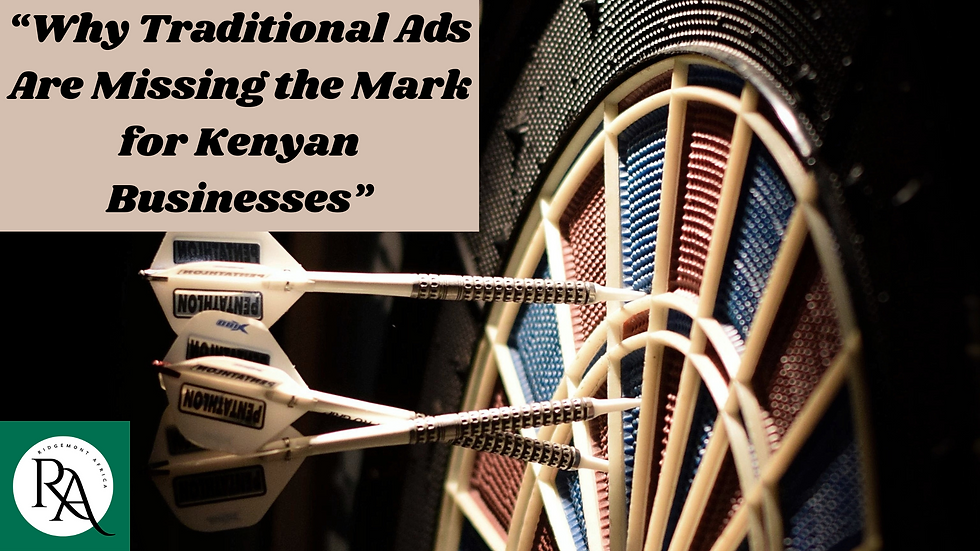“Why Traditional Ads Are Missing the Mark for Kenyan Businesses”
- Max Getuba
- Apr 30
- 3 min read

Not long ago, traditional advertising channels – radio jingles, billboard ads on the highway, newspaper classifieds – were the go-to methods for getting the word out. If you launched a new hotel or opened a school, you’d budget for a big banner in town or a spot on a popular radio show. But times have changed. Across Africa, and especially in Kenya, these older forms of advertising are delivering less return on investment (ROI) than they used to. Why? Because your customers’ attention has shifted elsewhere.
Let’s look at some eye-opening statistics. In 2014, radio was king in Kenya: over 90% of Kenyans tuned in regularly. Fast forward to recent years, and radio listenership has dropped dramatically – down to about 77% of the population. Newspaper readership fared even worse, plummeting from 21% of the population to just 7%. This isn’t because people lost interest in news or music; it’s because people migrated to digital platforms. In the same period, television viewership shot up (46% to 74%), and online access more than doubled (27% to 57%). In other words, Kenyans (and their African peers) are now spending more time looking at screens and less at billboards or print pages.
Think about your own daily experience or that of your customers. How many people in Nairobi are still buying a newspaper each morning? Very few. They’re getting news on their phones. How many are listening attentively to radio ads, versus streaming music on an app or catching up on YouTube videos? The audience is increasingly online and on mobile. In fact, Kenya recently made global headlines for leading in social media usage: Kenyans spend on average 3 hours and 43 minutes per day on social media, one of the highest in the world. This nearly four hours of daily social browsing far exceeds the time most people would spend reading print media or even listening to radio in the background.
What does this mean for the ROI of traditional ads? It means that the thousands of shillings you might spend on a newspaper ad or a highway billboard are reaching a shrinking, distracted audience. For example, if only 7% of the population even reads a newspaper, and most of those readers flip past ads, the effective impact of that expensive print advertisement is minimal. Similarly, radio might still reach a broad audience in some rural areas, but urban listeners have so many alternatives now (streaming services, podcasts, etc.) that your radio spot might go unheard or be quickly forgotten.
Moreover, traditional advertising often lacks precise targeting. A billboard on Uhuru Highway in Nairobi will be seen by many, but how many of those who see it are actually your target customers? If you run a specialized vocational college in Mombasa, a nationwide newspaper ad (with its high cost) will reach lots of people outside Mombasa who have no interest in your college. That’s wasted reach – and wasted money. Compare this to newer methods where you could spend the same money to show ads only to, say, parents of recent high school graduates within 20 km of Mombasa. We’ll get into those methods soon, but the point is clear: older channels are broad and blunt, and in today’s world, broad and blunt means inefficient.
To be fair, this doesn’t mean traditional media is entirely dead. In certain contexts – like local community radio in a village, or a billboard in an area with poor internet penetration – they can still play a role. But as a small or medium business in Africa looking for growth, you have to justify every shilling spent. And it’s getting harder to justify the old ways when the numbers tell us attention has moved elsewhere. A recent Kenyan media industry report even noted that despite the number of radio stations doubling from 2014 to 2023, overall radio engagement fell sharply as people shifted to TV and online. It’s a classic case of supply up, demand down.
In summary, the traditional advertising channels are not the workhorses they once were. Their decline in audience and engagement means a decline in their ROI. African businesses that continue to pour money solely into these channels risk shouting into an empty room. It’s time to follow where the eyes and ears have gone – and that journey leads us to the digital realm. But as we’ll see next, digital marketing has its own pitfalls if approached the wrong way.




Comments